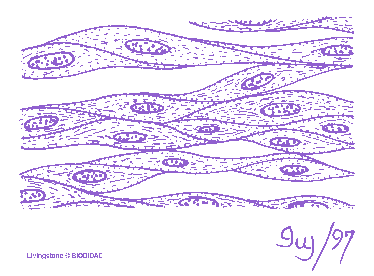Exoskeletons: Provide support for bodies; Provide external attachment for muscles
Disadvantages: limits size and movement; limits growthAdvantages: protection from predators; prevents dehydration
Endoskeletons: Provide support and protection for internal organs; Provide attachment for muscles; Covered with soft body tissues
Disadvantages: External organs are not protectedAdvantages: Size and growth are not limited; Internal organs protected
Bony Tissue
Periosteum: outer covering of bone.Compact bone: main tissue in the shaft of long bones. Surrounds yellow marrow, which stores fat.
Spongy bone: tissue in the ends of long bones and in flat bones; filled with red marrow, which makes red blood cells.
Osteocyte: bone cell
Ossification
A cartilage model develops a periosteum.The model enlarges to form a collar of bone deposited by osteoblasts.
The cartilage begins to calcify.
A blood vessel enters at the midpoint of the diaphysis and forms a primary ossification center.
Ossification continues toward the epiphyses and the bone grows in length.
Secondary ossification centers appear in the epiphyses.

Joints
Immovable jointsAllow little to no movementExample: sutures of skull
Gliding
Allow gliding movementsExample: vertebrae

Hinge JointsAllow movement in one directionExample: knee
Bones attached by ligaments
Ball and Socket
Allow movement in all directionsExample: hip
Bones attached by ligaments
Locomotion and Support
Porifera: sessile; spicules
Cnidaria: flip, float, false feet; no support
Platyhelminthes: mucous trail and cilia; hydroskeleton
Nematoda: longitudinal muscles; hydroskeleton
Annelida: setae, longitudinal and circular muscles; hydroskeleton
Gastropoda: mucous trail; shell secreted by mantle
Bivalvia: muscular foot used to burrow in sand; shell secreted by mantle
Cephalopoda: jet propulsion; internal pen
Echinodermata: tube feet; water vascular system
Crustacea: chelipeds, walking legs, swimmerets; chitinous exoskeleton
Arachnida: four pairs of walking legs; exoskeleton
Insecta: 3 pairs of walking legs, wings; chitinous exoskeleton
Chondrichthyes:fins, swimming; cartilaginous skeleton
Osteichthyes: fins, swimming; bony endoskeleton
Amphibia: muscles for walking, jumping; webbed feet for swimming; bony endoskeleton
Reptilia: ribs attached to scales; bony endoskeleton
Aves: feathers, wings; hollow bones, bony endoskeleton
Mammalia: muscles in appendages; bony endoskeleton

Muscles
Cardiac muscle: involuntary control; striated; located in the heart

Smooth muscle: involuntary control; not striated; located in hollow organs, such as the stomach

Skeletal muscle: voluntary control; striated; associated with bones, such as biceps brachii; attach to bones by tendons; usually work in pairs
flexor: bends jointextensor: straightens joint



